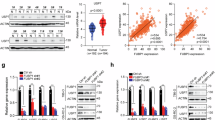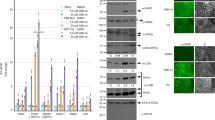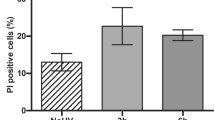Abstract
In this study, we describe a novel activating transcription factor 3 (ATF3)-dependent death pathway triggered by ultraviolet (UV) irradiation. We demonstrate that ATF3 contributes to UV-induced apoptosis through the regulation of hypoxia inducible factor (Hif)-2alpha expression, which in turn induces the expression of proapoptotic genes, such as Caspase7 or TRAIL (tumor necrosis factor (ligand) superfamily, member 10). Gain of function of Hif-2alpha as well as ATF3 is sufficient to trigger cell death, whereas loss of function of both proteins drastically inhibits UV-induced apoptosis. Repression of Hif-2alpha strongly impairs ATF3-mediated death, providing evidences that Hif-2alpha is the major death effector of ATF3. In addition, Hif-1alpha, already known as a proapoptotic gene, upon UV irradiation, is not able to compensate for the lack of Hif-2alpha expression, thereby confirming the major contribution of Hif-2alpha in UV-mediated cell death. We further demonstrate that this cascade of gene activation depends on p38 and c-Jun N-terminal kinase (JNK) activity. Impairment of such a pathway is likely to contribute to oncogenesis by promoting survival of cells that could accumulate severe chromosomal alterations.
Similar content being viewed by others
Log in or create a free account to read this content
Gain free access to this article, as well as selected content from this journal and more on nature.com
or
Abbreviations
- ATF3:
-
activating transcription factor 3
- UV:
-
ultraviolet
- Hif-2alpha:
-
hypoxia inducible factor 2 alpha
- Hif-1alpha:
-
hypoxia inducible factor 1 alpha
- TRAIL:
-
tumor necrosis factor (ligand) superfamily (member 10)
- JNK:
-
c-Jun N-terminal kinase
- EGR1:
-
early growth response 1
- EGR2:
-
early growth response 2
References
Bartkova J, Horejsi Z, Koed K, Kramer A, Tort F, Zieger K et al. DNA damage response as a candidate anti-cancer barrier in early human tumorigenesis. Nature 2005; 434: 864–870.
Gorgoulis VG, Vassiliou LV, Karakaidos P, Zacharatos P, Kotsinas A, Liloglou T et al. Activation of the DNA damage checkpoint and genomic instability in human precancerous lesions. Nature 2005; 434: 907–913.
Brash D, Ponten J . Skin precancer. Cancer Surv 1998; 32: 69–113.
Brash DE . Sunlight and the onset of skin cancer. Trends Genet 1997; 13: 410–414.
Thyss R, Virolle V, Imbert V, Peyron JF, Aberdam D, Virolle T . NF-kappaB/Egr-1/Gadd45 are sequentially activated upon UVB irradiation to mediate epidermal cell death. EMBO J 2005; 24: 128–137. epub 2004 Dec 16.
Virolle T, Adamson ED, Baron V, Birle D, Mercola D, Mustelin T et al. The Egr-1 transcription factor directly activates PTEN during irradiation-induced signalling. Nat Cell Biol 2001; 3: 1124–1128.
Dazard JE, Gal H, Amariglio N, Rechavi G, Domany E, Givol D . Genome-wide comparison of human keratinocyte and squamous cell carcinoma responses to UVB irradiation: implications for skin and epithelial cancer. Oncogene 2003; 22: 2993–3006.
Kool J, Hamdi M, Cornelissen-Steijger P, van der Eb AJ, Terleth C, van Dam H . Induction of ATF3 by ionizing radiation is mediated via a signaling pathway that includes ATM, Nibrin1, stress-induced MAPkinases and ATF-2. Oncogene 2003; 22: 4235–4242.
Hai T, Hartman MG . The molecular biology and nomenclature of the activating transcription factor/cAMP responsive element binding family of transcription factors: activating transcription factor proteins and homeostasis. Gene 2001; 273: 1–11.
Liang G, Wolfgang CD, Chen BP, Chen TH, Hai T . ATF3 gene. Genomic organization, promoter, and regulation. J Biol Chem 1996; 271: 1695–1701.
Lin YS, Green MR . Interaction of a common cellular transcription factor, ATF, with regulatory elements in both E1a- and cyclic AMP-inducible promoters. Proc Natl Acad Sci USA 1988; 85: 3396–3400.
Fan F, Jin S, Amundson SA, Tong T, Fan W, Zhao H et al. ATF3 induction following DNA damage is regulated by distinct signaling pathways and over-expression of ATF3 protein suppresses cell growth. Oncogene 2002; 21: 7488–7496.
Harper EG, Alvares SM, Carter WG . Wounding activates p38 map kinase and activation transcription factor 3 in leading keratinocytes. J Cell Sci 2005; 118: 3471–3485.
Hartman MG, Lu D, Kim ML, Kociba GJ, Shukri T, Buteau J et al. Role for activating transcription factor 3 in stress-induced beta-cell apoptosis. Mol Cell Biol 2004; 24: 5721–5732.
Hai T, Wolfgang CD, Marsee DK, Allen AE, Sivaprasad U . ATF3 and stress responses. Gene Expr 1999; 7: 321–335.
Ishiguro T, Nagawa H, Naito M, Tsuruo T . Inhibitory effect of ATF3 antisense oligonucleotide on ectopic growth of HT29 human colon cancer cells. Jpn J Cancer Res 2000; 91: 833–836.
Yan C, Jamaluddin MS, Aggarwal B, Myers J, Boyd DD . Gene expression profiling identifies activating transcription factor 3 as a novel contributor to the proapoptotic effect of curcumin. Mol Cancer Ther 2005; 4: 233–241.
Lu D, Wolfgang CD, Hai T . Activating transcription factor 3, a stress-inducible gene, suppresses Ras-stimulated tumorigenesis. J Biol Chem 2006; 281: 10473–10481.
Averous J, Bruhat A, Jousse C, Carraro V, Thiel G, Fafournoux P . Induction of CHOP expression by amino acid limitation requires both ATF4 expression and ATF2 phosphorylation. J Biol Chem 2004; 279: 5288–5297.
Le Brigand K, Russell R, Moreilhon C, Rouillard JM, Jost B, Amiot F et al. An open-access long oligonucleotide microarray resource for analysis of the human and mouse transcriptomes. Nucleic Acids Res 2006; 34: e87.
Rezvani HR, Dedieu S, North S, Belloc F, Rossignol R, Letellier T et al. Hypoxia-inducible factor-1alpha, a key factor in the keratinocyte response to UVB exposure. J Biol Chem 2007; 282: 16413–16422.
Yamaguchi K, Lee SH, Kim JS, Wimalasena J, Kitajima S, Baek SJ . Activating transcription factor 3 and early growth response 1 are the novel targets of LY294002 in a phosphatidylinositol 3-kinase-independent pathway. Cancer Res 2006; 66: 2376–2384.
Nakagomi S, Suzuki Y, Namikawa K, Kiryu-Seo S, Kiyama H . Expression of the activating transcription factor 3 prevents c-Jun N-terminal kinase-induced neuronal death by promoting heat shock protein 27 expression and Akt activation. J Neurosci 2003; 23: 5187–5196.
Kawauchi J, Zhang C, Nobori K, Hashimoto Y, Adachi MT, Noda A et al. Transcriptional repressor activating transcription factor 3 protects human umbilical vein endothelial cells from tumor necrosis factor-alpha-induced apoptosis through down-regulation of p53 transcription. J Biol Chem 2002; 277: 39025–39034.
Nawa T, Nawa MT, Adachi MT, Uchimura I, Shimokawa R, Fujisawa K et al. Expression of transcriptional repressor ATF3/LRF1 in human atherosclerosis: colocalization and possible involvement in cell death of vascular endothelial cells. Atherosclerosis 2002; 161: 281–291.
Acker T, Diez-Juan A, Aragones J, Tjwa M, Brusselmans K, Moons L et al. Genetic evidence for a tumor suppressor role of HIF-2alpha. Cancer Cell 2005; 8: 131–141.
Brusselmans K, Bono F, Maxwell P, Dor Y, Dewerchin M, Collen D et al. Hypoxia-inducible factor-2alpha (HIF-2alpha) is involved in the apoptotic response to hypoglycemia but not to hypoxia. J Biol Chem 2001; 19: 39192–39196.
Dai S, Kanenishi K, Ueno M, Sakamoto H, Hata T . Hypoxia-inducible factor-2alpha is involved in enhanced apoptosis in the placenta from pregnancies with fetal growth restriction. Pathol Int Nov 2004; 54: 843–849.
Qin JZ, Bacon P, Panella J, Sitailo LA, Denning MF, Nickoloff BJ . Low-dose UV-radiation sensitizes keratinocytes to TRAIL-induced apoptosis. J Cell Physiol 2004; 200: 155–166.
Yan C, Lu D, Hai T, Boyd DD . Activating transcription factor 3, a stress sensor, activates p53 by blocking its ubiquitination. EMBO J 2005; 24: 2425–2435.
Ishiguro T, Nakajima M, Naito M, Muto T, Tsuruo T . Identification of genes differentially expressed in B16 murine melanoma sublines with different metastatic potentials. Cancer Res 1996; 56: 875–879.
Beer DG, Kardia SL, Huang CC, Giordano TJ, Levin AM, Misek DE et al. Gene-expression profiles predict survival of patients with lung adenocarcinoma. Nat Med 2002; 8: 816–824.
Chen X, Cheung ST, So S, Fan ST, Barry C, Higgins J et al. Gene expression patterns in human liver cancers. Mol Biol Cell 2002; 13: 1929–1939.
Higgins JP, Shinghal R, Gill H, Reese JH, Terris M, Cohen RJ et al. Gene expression patterns in renal cell carcinoma assessed by complementary DNA microarray. Am J Pathol 2003; 162: 925–932.
Lapointe J, Li C, Higgins JP, van de Rijn M, Bair E, Montgomery K et al. Gene expression profiling identifies clinically relevant subtypes of prostate cancer. Proc Natl Acad Sci USA 2004; 101: 811–816.
Notterman DA, Alon U, Sierk AJ, Levine AJ . Transcriptional gene expression profiles of colorectal adenoma, adenocarcinoma, and normal tissue examined by oligonucleotide arrays. Cancer Res 2001; 61: 3124–3130.
Perou CM, Jeffrey SS, van de Rijn M, Rees CA, Eisen MB, Ross DT et al. Distinctive gene expression patterns in human mammary epithelial cells and breast cancers. Proc Natl Acad Sci USA 1999; 96: 9212–9217.
Sorlie T, Perou CM, Tibshirani R, Aas T, Geisler S, Johnsen H et al. Gene expression patterns of breast carcinomas distinguish tumor subclasses with clinical implications. Proc Natl Acad Sci USA 2001; 98: 10869–10874.
Yan C, Boyd DD . ATF3 regulates the stability of p53: a link to cancer. Cell Cycle 2006; 5: 926–929.
Cai Y, Zhang C, Nawa T, Aso T, Tanaka M, Oshiro S et al. Homocysteine-responsive ATF3 gene expression in human vascular endothelial cells: activation of c-Jun NH(2)-terminal kinase and promoter response element. Blood 2000; 96: 2140–2148.
Acknowledgements
We thank Tsonwin Hai (Department of Molecular and Cellular Biochemistry Center for Molecular Neurobiology) for the gift of the immortalized ATF3−/−mouse embryonic fibroblast and matching wild-type cells. We would also like to thank Dr. Pascal Barbry and Virginie Virolle (IPMC, Sophia Antipolis, France) for the supply and hybridization of human pangenomic microarrays. This work was supported by grants from Association pour la Recherche sur le Cancer (ARC), Société de Recherche en Dermatologie (SRD), Institut National de la Santé et de la Recherche Medicale (INSERM).
Author information
Authors and Affiliations
Corresponding author
Additional information
Edited by JP Medema
Supplementary Information accompanies the paper on Cell Death and Differentiation website (http://www.nature.com/cdd)
Rights and permissions
About this article
Cite this article
Turchi, L., Aberdam, E., Mazure, N. et al. Hif-2alpha mediates UV-induced apoptosis through a novel ATF3-dependent death pathway. Cell Death Differ 15, 1472–1480 (2008). https://doi.org/10.1038/cdd.2008.74
Received:
Revised:
Accepted:
Published:
Issue date:
DOI: https://doi.org/10.1038/cdd.2008.74
Keywords
This article is cited by
-
ATF3 in atherosclerosis: a controversial transcription factor
Journal of Molecular Medicine (2022)
-
Plk1, upregulated by HIF-2, mediates metastasis and drug resistance of clear cell renal cell carcinoma
Communications Biology (2021)
-
Atf3 deficiency promotes genome instability and spontaneous tumorigenesis in mice
Oncogene (2018)
-
ATF3 negatively regulates cellular antiviral signaling and autophagy in the absence of type I interferons
Scientific Reports (2017)
-
Phosphorylation and nuclear translocation of integrin β4 induced by a chemical small molecule contribute to apoptosis in vascular endothelial cells
Apoptosis (2013)



